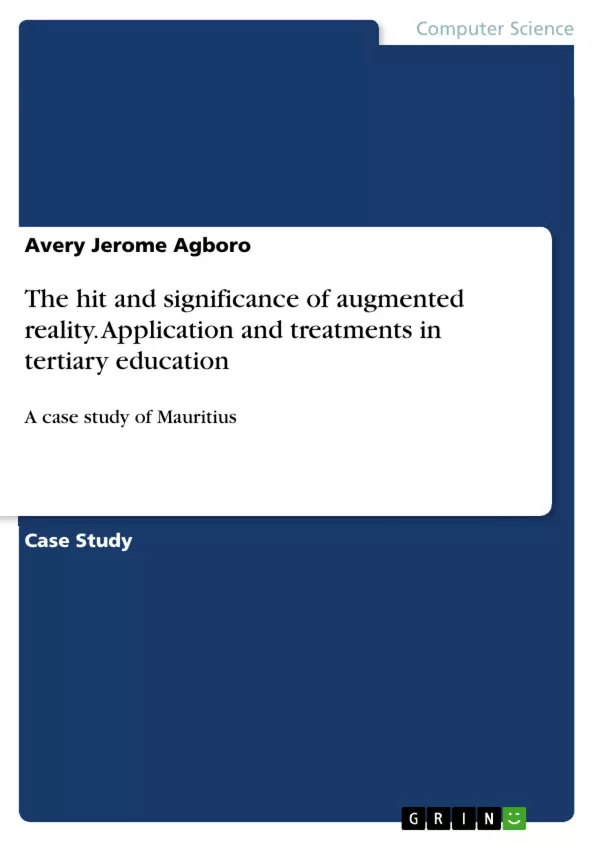The related study researched the effect of Augmented Reality (AR) on understudies' learning inside a tertiary training setting. Unequivocally, it measured learning upgrade levels, inspiration and the apparent acknowledgment of the innovation as members occupied with a lesson identifying with the human mind life systems. An aggregate of 80 exploration members from the Middlesex University Mauritius Branch Campus participated in the study. They were selected from an assortment of offices and relegated arbitrarily in a split 40:40 proportion to 2 bunches: (1) Augmented Reality Instruction (ARI); and (2) Traditional Instruction (TI).
In light of their allotted bunches, members were either treated to Augmented Reality based directions or Traditional 2D guidelines. Toward the end of the lesson, members from both gatherings were required to take a post-test taking into account what they had learnt. Moreover, members that participated in the Augmented Reality Instruction treatment, were additionally required to take a Technology Acceptance test. Investigation of results got from the post-tests of both ARI and TI treatment bunches, highlighted a solid huge distinction in learning picks up. Furthermore, the Technology Acceptance test taken by the ARI bunch likewise demonstrated that the utilization of AR, positively affected understudies' inspiration to learn, furthermore reflected as the fundamental purpose behind their acknowledgment of the innovation.
Inhaltsverzeichnis (Table of Contents)
- ABSTRACT
- TABLE OF CONTENTS
- CHAPTER 1: INTRODUCTION
- 1.1 Research questions and study objectives.
- 1.2 Overview
- CHAPTER 2: RESEARCH BACKGROUND
- 2.1 Concept and definitions
- 2.2 AR equipment prerequisites
- 2.2.1 Visualization shows gadgets
- 2.3 Field and industry implementations of ARI
- 2.3.1 Medical field
- 2.3.2 Military field
- 2.3.3 Retail and marketing industry
- 2.3.4 Tourism sector
- 2.4 AR implementations from learning perspective
- 2.4.1 The need for more research in the educational field
- 2.4.2 Hypothesis and research implications
- CHAPTER 3: DESIGN PROCEDURE AND CONSIDERATIONS
- 3.1 The concept
- 3.2 Application requirements
- 3.3 Software design considerations
- 3.3.1 3D modelling platform
- 3.3.2 Application development platform
- 3.3.3 Issues detected with Processing
- 3.4 Choice of hardware and justification
- CHAPTER 4: DEVELOPING THE ARBRAIN APPLICATION
- 4.1 Constructing the 3D brain model
- 4.1.1 Incorporating textual data
- 4.2 Developing the application centre
- 4.2.1 Development environment setup process
- 4.2.2 The venture creation
- 4.2.3 Introducing prefabs and GameObjects to the scene
- 4.1 Constructing the 3D brain model
- CHAPTER 5: METHODOLOGY
- 5.1 Research Design
- 5.2 Instruments design
- 5.2.1 Multi-choice questionnaire
- 5.2.2 Technology acknowledgment poll
- 5.3 Study members
- 5.4 Ethical considerations
- 5.5 AR and conventional guideline treatments
- 5.6 Procedure
- CHAPTER 6: ANALYSIS
- 6.1 Post-test analysis results
- 6.2 Technology acceptance analysis and results
- 6.2.1 Constructive reliability
- 6.2.2 Delight Users (DU) imputes results
- 6.2.3 Users ease of usage (UEOU) imputes results
- 6.2.4 System usability (SU) imputes results
- 6.2.5 Aesthesis users (AU) imputes results
- CHAPTER 7: DISCUSSION
- 7.1 Study limitations
Zielsetzung und Themenschwerpunkte (Objectives and Key Themes)
This research aims to analyze the impact of an Augmented Reality (AR) instructional treatment on tertiary level students in Mauritius. The primary goal is to evaluate the effectiveness of AR in improving learning, increasing motivation, and enhancing student acceptance of the technology within a tertiary education context.
- Impact of AR on student learning and knowledge acquisition.
- The effect of AR on student motivation and engagement.
- Student acceptance and perception of AR as a learning tool.
- Development and implementation of an AR application for tertiary education.
- Comparison of AR-based learning with traditional instructional methods.
Zusammenfassung der Kapitel (Chapter Summaries)
The text delves into the application of Augmented Reality (AR) in tertiary education, specifically focusing on a case study in Mauritius. Chapter 1 introduces the research questions and objectives, highlighting the need for further research on AR in tertiary settings. Chapter 2 explores the background of AR, its definitions, equipment prerequisites, and implementations across various fields and industries. Chapter 3 details the design procedure and considerations for developing the AR application, including the choice of software and hardware. Chapter 4 focuses on the development of the "ARBrain" application, explaining the construction of the 3D brain model and the application development process. Chapter 5 outlines the research methodology, including the research design, instruments used, participant selection, ethical considerations, and treatment procedures. Chapter 6 presents the analysis of the data collected, focusing on the results from the post-test and the technology acceptance test. Chapter 7 discusses the limitations of the study.
Schlüsselwörter (Keywords)
The study investigates the impact of Augmented Reality (AR) in tertiary education, specifically exploring its application in learning and its influence on student motivation and technology acceptance. Key terms include Augmented Reality, Tertiary Education, Learning, Motivation, Technology Acceptance, and AR-based Instruction.
- Quote paper
- Avery Jerome Agboro (Author), 2016, The hit and significance of augmented reality. Application and treatments in tertiary education, Munich, GRIN Verlag, https://www.grin.com/document/342425



